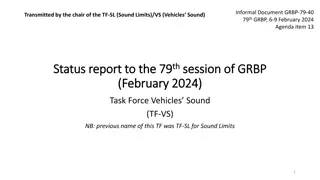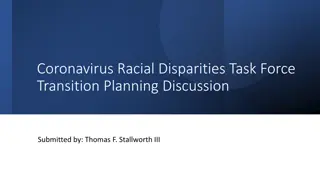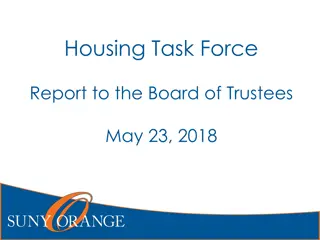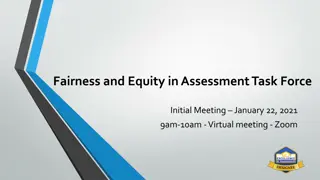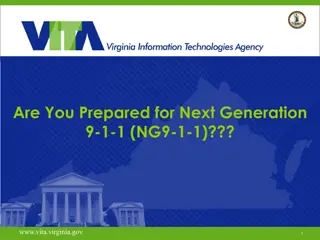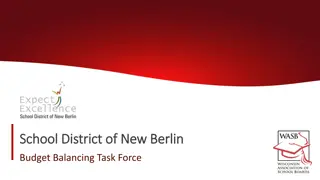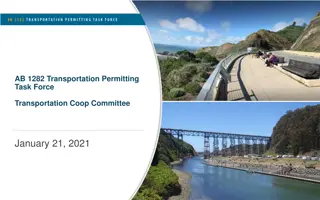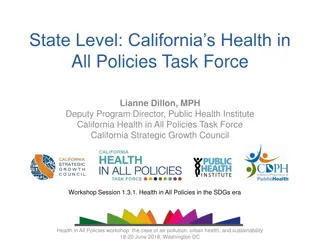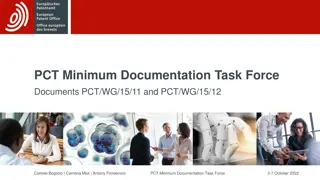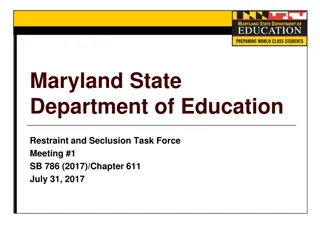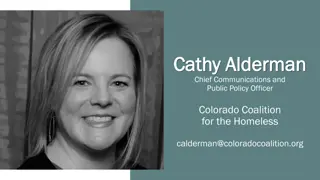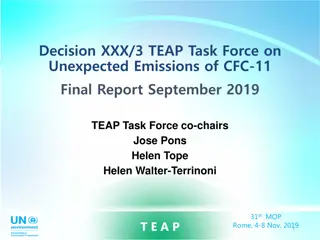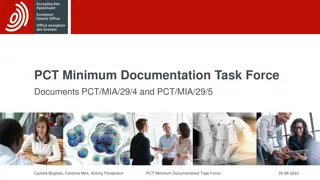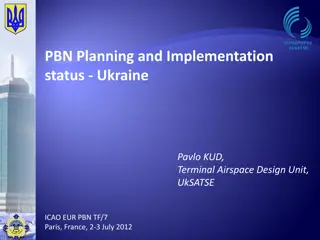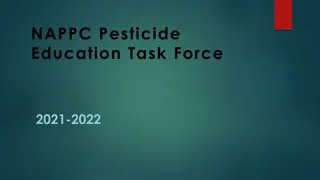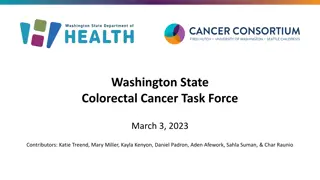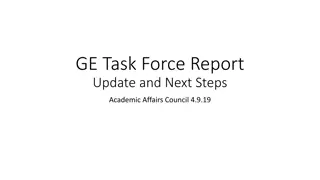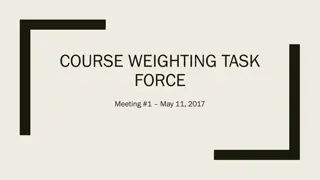Optimal Approach to NG9-1-1 Implementation: Task Force Report
Task Force on Optimal PSAP Architecture releases a report detailing the optimal approach to Next Generation 9-1-1 implementation. The report discusses the NG9-1-1 ecosystem, transitional steps, public safety migration steps, and foundational elements necessary for a successful transition to NG9-1-1. Key elements include ESInet infrastructure, IP PSAP capability, and GIS data preparation. The report outlines the necessary steps for authorities to prepare for NG9-1-1 effectively and emphasizes the importance of establishing foundational elements.
Download Presentation

Please find below an Image/Link to download the presentation.
The content on the website is provided AS IS for your information and personal use only. It may not be sold, licensed, or shared on other websites without obtaining consent from the author. Download presentation by click this link. If you encounter any issues during the download, it is possible that the publisher has removed the file from their server.
E N D
Presentation Transcript
Federal Communications Commission Task Force on Optimal PSAP Architecture Working Group 2: Working Group 2: Optimal Approach to NG9-1-1 Implementation Status Report September 23, 2016
Introduction 2 David Holl, ENP, WG2 Chair TFOPA WG2 NG9-1-1 Optinal PSAP Architecture
Introduction Task Force on Optimal PSAP Architecture (TFOPA) released an Adopted Final Report January 29, 2016 Section 5 of the Report was titled Optimal Approach to NG9-1-1 Architecture Implementation by PSAPs and contained the initial efforts of WG2 in laying a foundational understanding of the various component parts of the Next Generation 9-1-1 environment. Part of this work was to initiate a discussion and understanding of what we termed the NG9-1-1 Ecosystem TFOPA WG2 NG9-1-1 Optinal PSAP Architecture 3
NG9 NG9- -1 1- -1 1 EcoSystem EcoSystem 4
NG9-1-1 Transition Steps NG9-1-1 Transitional Steps NG9-1-1 Transitional NG9-1-1 Legacy 9-1-1 5-D
PUBLIC SAFETY MIGRATION STEPS TO NG9-1-1 Foundation Elements Establish ESINet Infrastructure (IP Network and Softswitch) Advanced Applications and Data Services IP PSAP Additional Requests for Assistance Types GIS Data Preparation (Location Validation, Routing, Service Identification) Evolution of the overall environment(s) (Roles, Regulations, Tariffs, Funding, Incumbents, FCC, State ) i3 NENA vision end-state fully realized Carrier s establish LIS and deliver a routable PIDF-LO with call setup Establish i3 core functions while managing transitional elements Interoperate with changing Telecommunications Industry (LVF, E-CSCF, IMS, NNI, IETF, Internet) Many paths and steps to the long term NG9-1-1 vision i3 vision issue resolutions Today Months Years Many Years 6-D
NG9-1-1 Foundational Elements 9-1-1 Authorities need to develop an understanding of the steps appropriate for them and their specific situation There are three primary capabilities or Foundation Elements that must be established to prepare for NG9-1-1: o ESInet (transport network) o IP PSAP (i3 capable) o GIS Data Preparation These elements do not necessarily need to be accomplished simultaneously or in any particular order, but will be driven by the 9-1-1 Authorities goals and NG9-1-1 transition plan 7-D
NG9-1-1 Deployment Chart ESInet deployment GIS data Deployed locally, operated regionally according to state standards Security Statewide GIS Repository created for LVF & ECRF NG9-1-1 Core Services Security plan implemented and deployed Integrated technology supports multiple PSAPs NG9-1-1 GIS database created Applications ESRP/ECRF/PRF Based upon NENA i3 standards CSRIC and NGSEC integrated into state plan Based upon NENA i3 standards LVF when needed Identify and deploy enhanced applications Based upon NENA i3 standards Based upon NENA i3 standards Integrate with NG9-1-1, PSAP and other operating environments, as appropriate. Based upon NENA i3 standards 8-D
NG9-1-1 Transition Planning Essential 9-1-1 Authorities need to understand that NG91-1-1 is a NEW Paradigm in 9-1-1 technology and processes 9-1-1 Authorities need to develop an in-depth NG9-1-1 transition plan With proper planning, Next Generation 9-1-1 Core Services, as described in Working Group reporting, can be implemented in a reasonable time frame Through economies of scale 9-1-1 Authorities can minimize transitional costs and maintain positive outcomes with maximum fiscal responsibility 9-T
Introduction WG2 Subgroup Divisions WG2 Subgroup Divisions NG911 Framework NG911 Framework NG911 Scorecard NG911 Scorecard NG911 Training and Education NG911 Training and Education NG911 Transport NG911 Transport - - ESInet Implementation Case Studies ESInet Implementation Case Studies Lessons Learned Lessons Learned 1. 1. 2. 2. 3. 3. 4. 4. Each group is tasked with research, analysis, and discussions pertaining to their subject area(s) and developing drafts of the anticipated final report sections and recommendations. WG2 holds weekly conference calls to discuss subgroup work. TFOPA WG2 Optimal NG9-1-1 Service Architecture 10
Task 2A NG9-1-1 Planning Framework Roger Hixson TFOPA WG2 NG9-1-1 Optinal PSAP Architecture
Task 2A NG Planning Framework WG 2A members: WG 2A members: Roger Hixson Roger Hixson co Bill Mertka Bill Mertka co o Bob Bob Brown Brown o Dusty Rhoads Dusty Rhoads o Bernard Aboba Bernard Aboba o Mark Mark Fletcher Fletcher o Chuck Vick Chuck Vick o Mike Nelson Mike Nelson o Jim Goerke Jim Goerke o Jeff Wittek Jeff Wittek co- -lead lead co- -lead lead TFOPA WG2 Optimal NG9-1-1 Service Architecture 12
Task 2A NG Planning Framework Objectives: Expansion of Report 1 s content to support specific NG9-1-1 planning efforts by 9-1-1 Authorities o Guidance document for 911 authorities planning their transition to NG911 o Implementations following state and local considerations using the TFOPA Final Report (January 2016) in planning for an optimal configuration of the necessary components o Combining narrative and diagrams Integration with the NG9-1-1 Readiness Checklist (SG 2B) Begin by describing current 9-1-1 environment (support readers who do not have the basics, because they weren t around for E9-1-1 implementations) TFOPA WG2 Optimal NG9-1-1 Service Architecture 13
Task 2A NG Planning Framework Planning for Transition utilizing the 2015 Report content Report Structure: Readiness and Readiness Assessment The Need for Planning and Strong Governance OSE Access to NG9-1-1 Systems locally and nationally Governance and Planning for NG9-1-1 central Core Services ESInet transport network planning TFOPA WG2 Optimal NG9-1-1 Service Architecture 14
Task 2A NG Planning Framework Report Structure (cont d) PSAP Planning and Transition (assumed part of 2B content) Interaction with Responder Broadband Networks Pros and Cons for County, region, State, and multi- state hosted options Considerations and Recommendations Appendices TFOPA WG2 Optimal NG9-1-1 Service Architecture 15
Task 2A NG Planning Framework Status: SG 2A meets weekly, and will meet as necessary as final content is developed and reviewed About 70% of text is drafted and in review Coordination with the SG 2B Checklist is underway Conduct additional discussions with other Workgroups to insure alignment TFOPA WG2 Optimal NG9-1-1 Service Architecture 16
Task 2B NG911 Scorecard Jeff Wittek TFOPA WG2 NG9-1-1 Optinal PSAP Architecture
Task 2B NG911 Scorecard WG2B MEMBERS WG2B MEMBERS o Dave Holl, WG2 Chair o Mary Boyd, WG2B Subgroup Co-Chair o Jeff Wittek, WG2B Subgroup Co-Chair o Alfredo Bocanegra o April Heinze o Bob Brown o Dusty Rhoads o Laurie Flaherty o Mark Fletcher o Mike Nelson o Jim Goerke o Joe Heaps o Roger Hixson TFOPA WG2 Optimal NG9-1-1 Service Architecture 18
Task 2B NG911 Scorecard TASK TASK Development of a NG9-1-1 Readiness Scorecard describing the operational, technical, cyber, and workforce factors that would constitute declaring a PSAP NG911 Ready. From a cyber perspective the scorecard will include the minimum identity, credentialing, and access management measures (iCAM) that need to be in place for a PSAP to be considered NG911 ready . TFOPA WG2 Optimal NG9-1-1 Service Architecture 19
Task 2B NG911 Scorecard WORK TO DATE WORK TO DATE o WG2B subgroup meeting weekly o During those meetings the subgroup has dealt with several fundamental issues; NG911 Definition NG911 Implementation Maturity Continuum NG911 Implementation Maturity State Definitions Identification of key NG911 required elements (components, functions, processes and procedures) and their placement within the NG911 Implementation Maturity Continuum WORK PRODUCT WORK PRODUCT o DRAFT NG911 Readiness Scorecard spreadsheet created TFOPA WG2 Optimal NG9-1-1 Service Architecture 20
Task 2B NG911 Scorecard NEXT STEPS NEXT STEPS Finalize certain NG911 Readiness Scorecard sections Conduct additional discussions other Workgroups to insure alignment Transfer NG911 Readiness Scorecard into report format TFOPA WG2 Optimal NG9-1-1 Service Architecture 21
Task 2B NG911 Scorecard REPORT STRUCTURE REPORT STRUCTURE Introduction o Project Scope o Limitations What is NG911? o NENA NG911 Definition o How the NG911 Readiness Scorecard further defines NG911 NG9-1-1 Transition o National 9-1-1 Program Office NG911 Implementation Maturity Model Maturity State Definitions o NG911 Readiness Scorecard Implementation Maturity Continuum Maturity State Definitions Glossary of Terms TFOPA WG2 Optimal NG9-1-1 Service Architecture 22
Task 2B NG911 Scorecard REPORT STRUCTURE REPORT STRUCTURE NG911 Readiness Scorecard & Explanation o Purpose o Benefit o Structure o Usage Self-Assessment Matrix & Explanation o Purpose o Benefit o Structure o Usage Appendices TFOPA WG2 Optimal NG9-1-1 Service Architecture 23
Task 2C Training and Education April Heinze TFOPA WG2 NG9-1-1 Optinal PSAP Architecture
Task 2C Training and Education WG2C WG2C MEMBERS MEMBERS o Dave Holl, WG2 Chair o Mary Boyd, WG2C Subgroup Co-Chair o April Heinze, WG2C Subgroup Co-Chair o Patti West o Alfredo Bocanegra o Mark Fletcher o Bradley Blanken TFOPA WG2 Optimal NG9-1-1 Service Architecture 25
Task 2C Training and Education TASK TASK Study workforce challenges associated with the NG911 Architecture described in the Final Report, with special considerations to: o Potential staffing impacts and requirements for PSAPs and any shared resource facilities for NG911 o Identify any operation guidelines for proper use of facilities and/or shared services that may need to be created. o Determine Cybersecurity training and education that will need to be created. TFOPA WG2 Optimal NG9-1-1 Service Architecture 26
Task 2C Training and Education STAFFING IMPACTS STAFFING IMPACTS o Technical o Alarm Processing o GIS Data o MSAG/GIS Routing o Recording o Cutover TFOPA WG2 Optimal NG9-1-1 Service Architecture 27
Task 2C Training and Education OPERATIONAL CONSIDERATIONS OPERATIONAL CONSIDERATIONS o Project Management o Updating PSAP 9-1-1 Plans and/or Strategic Plans o Identify All Operational Impacts o Hiring Considerations o Standard Operating Procedures o Training o Ongoing Operational Review TFOPA WG2 Optimal NG9-1-1 Service Architecture 28
Task 2C Training and Education TECHNICAL CONSIDERATIONS TECHNICAL CONSIDERATIONS o Most PSAPs do not have their own IT or GIS employees PSAPs must evaluate the impacts of the workload level for: Implementation overall system care alarm processing recording needs on-going maintenance GIS data accuracy levels MSAG/GIS routing TFOPA WG2 Optimal NG9-1-1 Service Architecture 29
Task 2C Training and Education Workgroup Progress To Date Workgroup Progress To Date o WG2C subgroup meeting weekly o Report framework is completed o Draft is in progress Next Steps Next Steps o Will work with WG2B to incorporate necessary checklist items into the training and education document o Will work with WG1 to incorporate cybersecurity training and educational needs TFOPA WG2 Optimal NG9-1-1 Service Architecture 30
Task 2D ESInet Lessons Learned 31 Alicia Burns TFOPA WG2 NG9-1-1 Optinal PSAP Architecture
Project OBJECTIVES Interview various ESInet Deployment early adopters Gleaning information : Best Practices Overall Challenges Lessons Learned
PROCESS As a separate sub-group effort : Conduct a series of Interviews/User Case Studies Selected Guest speakers from a variety of Early Adopter ESInet deployment situations (statewide, regional, local, etc.). Each Guest Speaker would address a set of common, data gathering type questions related to areas of interest (challenges, lessons learned, and funding, architecture, cybersecurity, etc.)
PROCESS All entities we spoke with, were asked the same, common set of criteria and questions. Areas covered included: 1. Planning 2. Procurement/financials 3. Implementation 4. Ongoing Operations If you started the project over today, what 3 things would you change?
UPDATE Interviews with 5 PSAP entities have been completed o State of Maine o State of Iowa o State of Massachusetts o Palm Beach County Florida o NCTCOG North Central Texas Council of Governments
UPDATE Status We re finishing interviews. Remaining sites include: State of Utah, BRETSA/Boulder County CO, State of Indiana, and State of Minnesota. Completing the summaries for each, analyzing/trending the responses we got, and drafting the executive summary for our final report. Sharing these interviews with the entire TFOPA membership. Coordinating with the other WG2/WG3 sub-groups, sharing information.
RESULTS From the start, we recognized these interviews would yield an incredible amount of invaluable information, for the next guy PSAP who is getting ready. Every one of our interviews to date, has done that, plus more! From how they paid for it, how it went together, to what their struggles were, etc. Collectively, our sub-group members all agree, a look into ESInet early adopters/Lessons Learned is beneficial, and should be continued for some time to come. These completed interviews should be shared within the Public Safety industry, and stored in a library, available when requested.
WG2 Summary TFOPA WG2 NG9-1-1 Optinal PSAP Architecture
WG2 Summary WG2 s continued goal is to further refine and define to component parts of the Ecosystem that is and will be Next Generation 9-1-1 to assist PSAPs, 9-1-1 Authorities, government interests, policy development groups and all parties committed to NG9-1-1 in the planning, framework, and implementation checklist (scorecard) necessary to move from legacy, to transitional, to fully deployed NG9-1-1 TFOPA WG2 Optimal NG9-1-1 Service Architecture 39
Ng9-1-1 migration and deployment planning PSAPs should work with their 9-1-1 Authority to create an overall plan and progression chart for their particular situation In cases where there is no established 9-1-1 Authority, PSAPs should first address their organizational approach and financial capabilities to move forward A plan should include the basic migration steps explained above and move toward the more detailed functional capabilities and functional elements 40
Path Forward to NG9-1-1 Deployment The overarching GOAL of WG2 in this Phase of TFOPA is to assist PSAPs, 9-1-1 Authorities, and all entities with vested interests in the advancement of NG9-1-1 Nationwide to develop a better understanding of where we are and were we need to go by putting forth a: o Planning Framework o Scorecard of NG9-1-1 Transitional Evolution o Education and Training Required for NG9-1-1 o ESInet (transport medium) lessons learned TFOPA WG2 NG9-1-1 Optinal PSAP Architecture 42
PSAP and 9-1-1 Authorities Challenge The challenge for the 9-1-1 community is to openly embrace the new NG9-1-1 Paradigm and build new cooperative relationships for Planning and Implementing NG9-1-1 systems With the tools that will be provided by this Working Group we believe conscientious members of the 9- 1-1 community will continue to make progress in efficiently and effectively transitioning the 9-1-1 system from legacy to full deployment of NG9-1-1 TFOPA WG2 NG9-1-1 Optinal PSAP Architecture 43
Questions or Comments TFOPA WG2 Optimal NG9-1-1 Service Architecture 44



